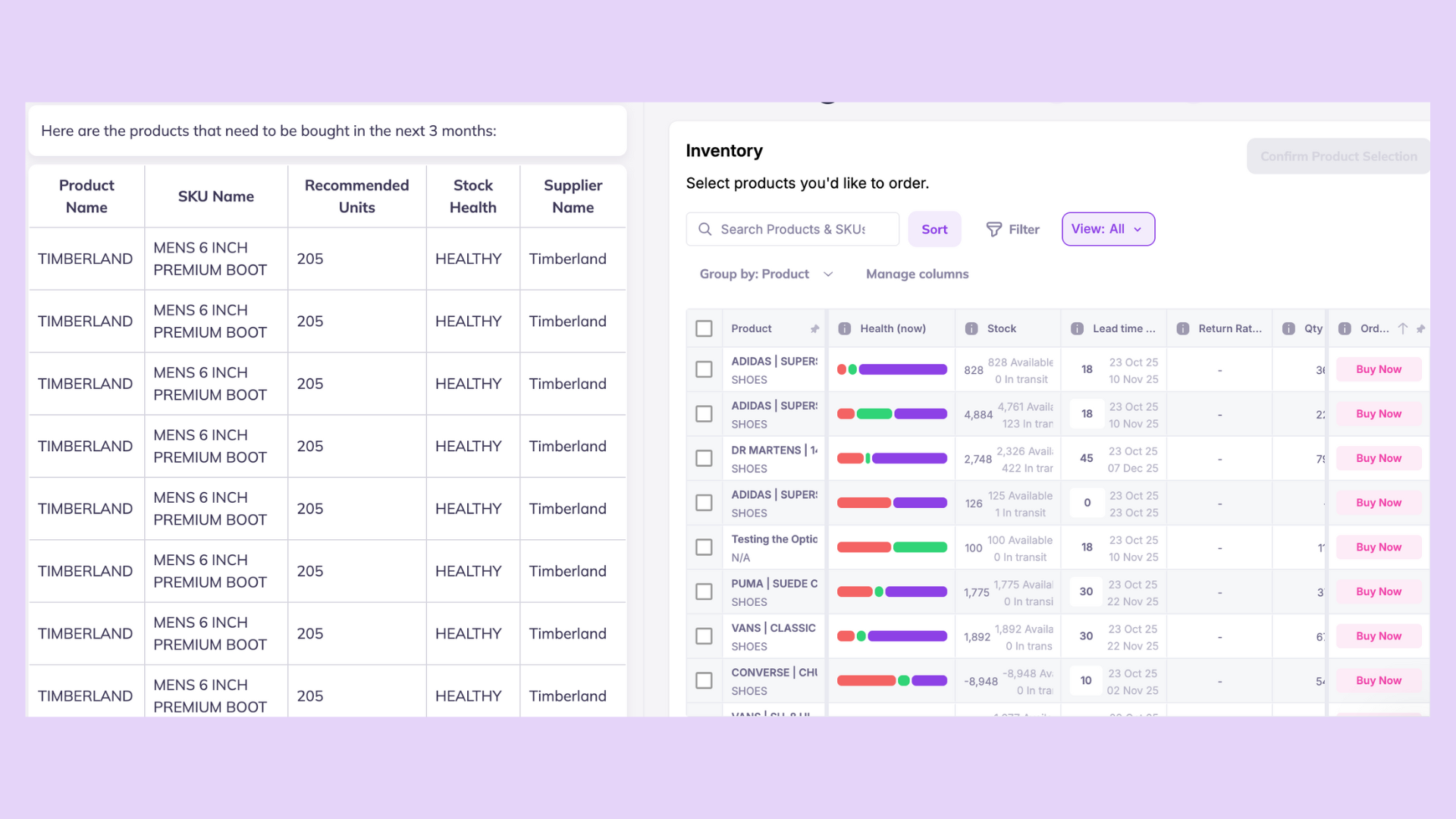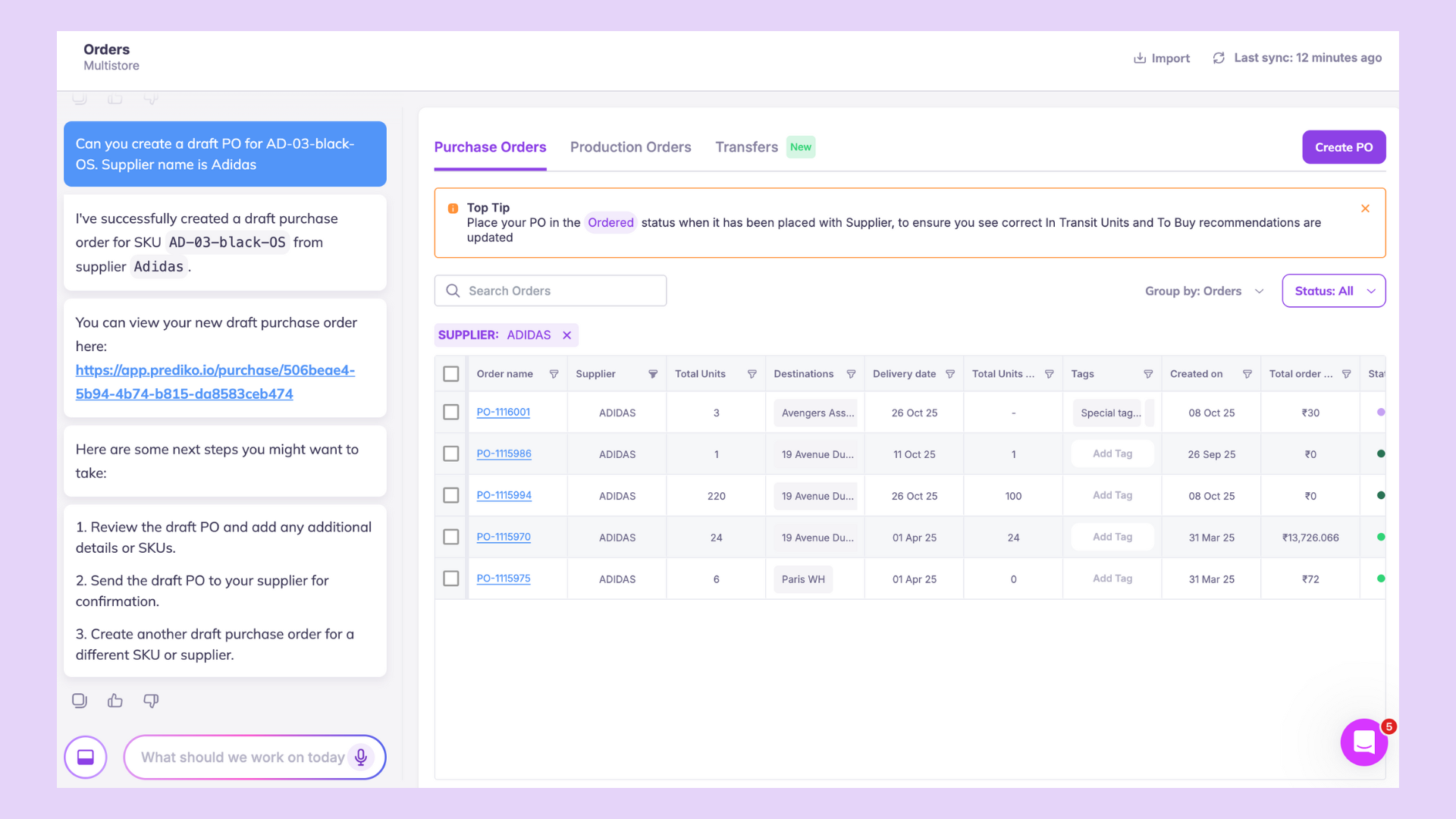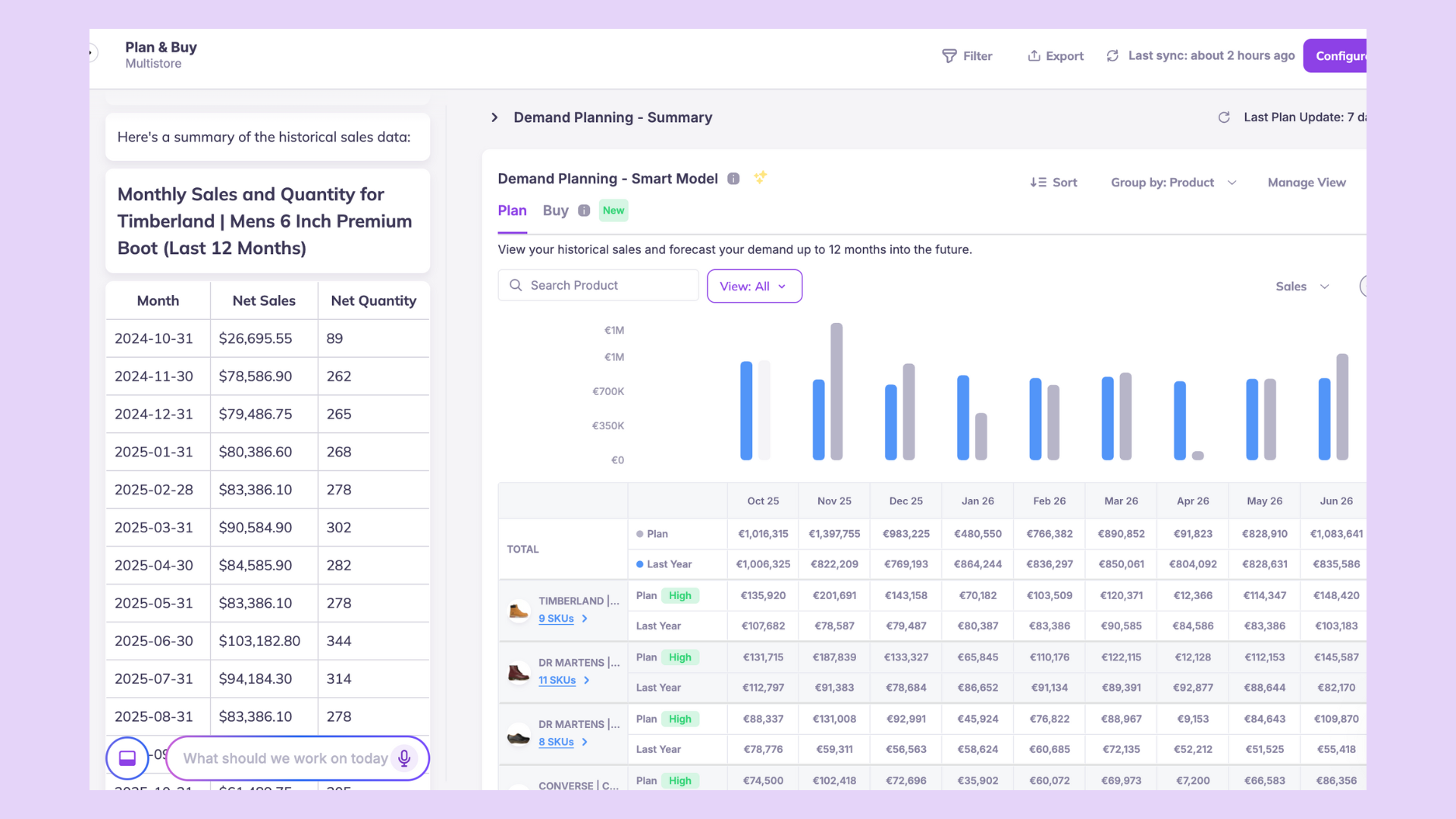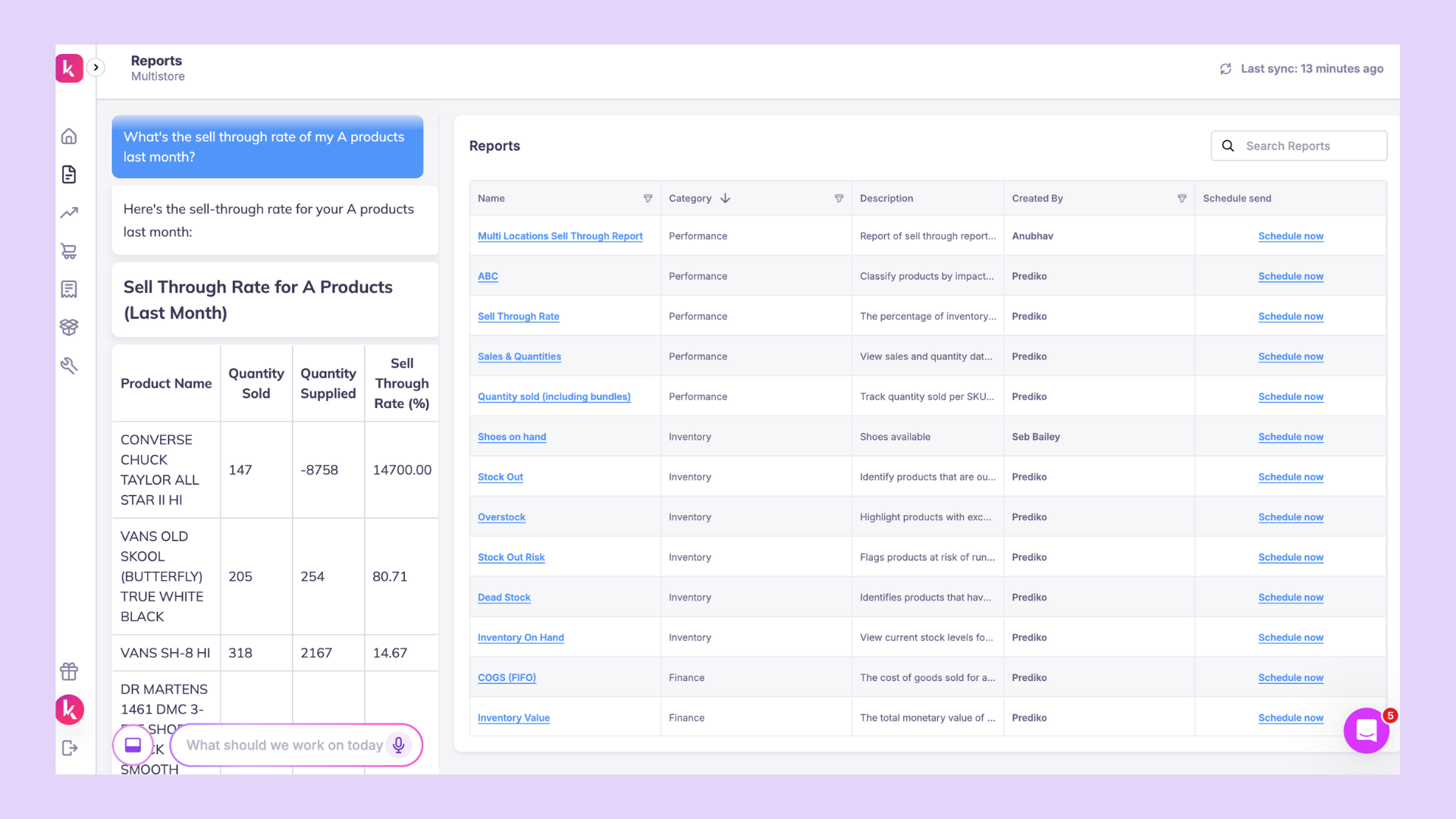Yesterday, my manager built a full-fledged marketing asset using a ChatGPT agent. What normally takes a full day –research, structuring, and drafting– was wrapped up in just an hour.
The asset went live the same day and was already automating our tasks and streamlining processes. And it’s not just us. Adoption is accelerating fast; nearly 80% of organizations are using AI agents, and 96% plan to expand in 2025.
Inventory is no different. AI agents are now being trained to forecast demand, track stock health, and even generate purchase orders with almost no manual input.
Today, we’ll explore real-world AI agent examples and how they are changing the way brands plan, manage, and scale their operations.
What Are AI Agents? (And Why They Are Gaining Popularity in 2025)
An AI agent is an intelligent system that can think through tasks and act on its own. Instead of just following one command at a time, they can plan steps, remember what’s happened before, and work towards a goal.
For example, a chatbot might answer a customer’s shipping question, but an AI agent can check inventory, create a purchase order if stock is low, and notify the warehouse, all without being explicitly told each step.
Unlike traditional automation tools that follow pre-set rules, or chatbots that mainly answer questions, what makes AI agents different is their ability to
- Act autonomously: They don’t just wait for inputs; they decide the next steps
- Use memory: They recall past interactions and data, adjusting behavior over time
- Handle multi-step reasoning: They can break down complex goals (like planning inventory for a product launch) into smaller actions and execute them sequentially
This is exactly why businesses are turning to AI agents in 2025.
Instead of just automating repetitive tasks, companies are using them for complex decision-making —from competitor monitoring and handling customer queries to forecasting demand and reallocating resources.
How to Use These AI Agents Examples
Reading examples is one thing, and turning them into action is another. The real value of AI agent examples comes when you connect them to the specific bottlenecks in your business.
Start by mapping your daily workflows, where time gets wasted or decisions depend on instincts. That’s where AI agents can plug in.
If you spend hours adjusting forecasts, let a demand planning agent learn from your sales data. If customer queries slow you down, test a customer support agent to handle those automatically.
You don’t have to replace everything overnight. Begin with one high-impact process, measure the results, and expand from there.
The goal isn’t to add another tool. It’s to design a system where work gets done faster, data flows seamlessly, and your team focuses on growth instead of maintenance.
Types of AI Agents With Examples
Now, AI agents are showing up across every part of ecommerce. To make it simple, we’ve grouped these examples by key business functions.
1. AI Agents Examples for Inventory Operations
Inventory is where every brand feels the weight of growth; too much stock ties up cash, too little loses sales.
The following inventory AI agents automate the full cycle, from forecasting and reordering to supplier coordination, keeping inventory lean and responsive without manual checks.
1.1 Inventory management agent
Problem: As brands scale, tracking thousands of SKUs across channels becomes messy. Stockouts, overstocking, and inaccurate data waste cash and kill momentum.
What it does: An AI inventory management agent helps monitor stock levels, predict future demand using AI, identify when stock levels are at risk, and trigger reorders before stockouts happen.
Prediko’s AI Agent allows Shopify brands to manage their entire inventory operation through simple natural language commands. You can ask it to “show me SKUs with less than 10 days of coverage”, and it responds instantly, pulling live data from your Shopify account and executing actions like creating draft POs.

It even remembers the context of your session, so if you’ve been reviewing low-stock products, you can follow up instantly. These kinds of tools are reshaping how brands manage AI SKU optimisation at scale—automating decisions that used to take hours and improving SKU-level performance across channels.
Impact: This leads to faster decision-making, fewer stockouts, improved inventory turnover, and less cash locked in excess stock.
1.2 Purchase order automation agent
Problem: Manually creating and tracking purchase orders slows down operations and leads to missed supplier deadlines or duplicate orders.
What it does: A purchase order automation agent removes that burden with 1-click or automated generation of POs based on real-time stock and sales data.
If you’re using Prediko’s AI Agent, you can update delivery dates, switch PO statuses, or create new orders instantly through natural language commands.

Impact: This eliminates manual tracking, keeping every PO accurate and on schedule. Your restocking becomes faster, more reliable, and scalable as order volume grows.
2. AI Agents Examples for Data and Analytics
With data pouring in from sales, marketing, and operations, the challenge isn’t access for ecommerce brands; it’s clarity.
AI agents turn scattered data into actionable insights, helping teams make faster, smarter decisions without waiting on manual reports or spreadsheet cleanup.
Some generative AI agent examples for data and analytics include.
2.1 Financial insights agent
Problem: Finance folks spend hours compiling spreadsheets to understand revenue trends, margins, or spend breakdowns. This prevents prompt action or course-correction.
What it does: A financial insights agent connects with Shopify, ad platforms, and accounting tools to deliver instant summaries and visual reports.
You can ask plain-language questions like “What was our gross margin last month?” and get real-time answers, without touching a spreadsheet.
Impact: Faster financial decisions and quicker reporting to the stakeholders.
2.2 Inventory forecasting agent
Problem: Forecasting inventory is time-consuming, data-intensive, and error-prone, especially when dealing with hundreds of SKUs across locations and fluctuating demand.
What it does: An AI forecasting agent uses sales, seasonality, and growth patterns to predict future demand and recommend reorder quantities. It adjusts forecasts automatically based on trends, promotions, or new launches.
For example, Prediko’s AI Agent generates SKU-level demand forecasts, refreshes plans based on new data, and factors in seasonality, promotions, or upcoming product launches.

It even considers bundle or BOM demand to calculate total material needs. This places it among the most powerful AI demand planning tools available to fast-growing Shopify brands. You can adjust forecasts manually, run “what-if” scenarios, and review insights on which SKUs need attention, all through simple chat commands.
Impact: More accurate forecasts, fewer stockouts, and balanced inventory across channels.
2.3 Performance reporting agent
Problem: Reporting cycles can take days, with teams manually compiling updates from different systems or departments just to track KPIs or campaign performance.
What it does: A performance reporting agent automates report creation, visualization, and distribution. It gathers metrics across different functions to produce weekly or daily reports.e
Prediko’s AI Agent, for instance, can create, open, and schedule sales and inventory reports on demand or even send them to your inbox at fixed times every day or week. So instead of asking your team for updates, you just ask your agent.

Impact: Consistent visibility, faster insights, and hours saved every week in manual reporting.
3. AI Agents Examples for Product and Catalog Management
Product and catalog management can easily become chaotic, especially when you’re juggling hundreds of SKUs across channels.
The following autonomous AI agent examples show how they can automate data cleanup, enrichment, and optimization.
3.1 Product attribute extraction agent
Problem: Managing large product catalogs often leads to missing details (like material, color, or size) which can hurt listing quality, SEO visibility, and ad performance.
What it does: This agent automatically scans product titles, descriptions, and images to identify and standardize key attributes. It cleans up messy data, enriches missing fields, and ensures every SKU is accurately categorized.
Delivery Hero, an online food ordering and delivery company uses agentic AI to automatically build and maintain its product knowledge base; extracting, cleaning, and updating catalog information in real time to keep data consistent across all platforms.
Impact: Improved catalog accuracy, cleaner product feeds, and fewer sync errors when pushing listings to Facebook, Google, or marketplaces.
3.2 Competitor monitoring agent
Problem: Manually tracking competitor pricing, promotions, and launches is time-consuming and reactive. By the time you notice a competitor’s price drop, you’ve already lost sales.
What it does: This agent automatically scans public competitor listings and pricing feeds, comparing them to your SKUs. It flags anomalies, price gaps, and promotional trends, then delivers a summary or alert straight to your inbox or Slack.
Crayon AI is one such tool that uses generative AI to automatically create ready-to-share summaries of news articles, blog posts, and press releases of competitors.
Impact: Real-time pricing intelligence, proactive promotional planning, and the ability to react quickly before your competition does.
3.3 Content optimization agent
Problem: Every platform and its audience behaves differently. Optimizing product titles, descriptions, blogs, and emails one-by-one is tedious and inconsistent. This affects both discoverability and conversion.
What it does: A content optimization agent reviews your listings or content and identifies opportunities for SEO and conversion improvement. It analyzes keywords, readability, and engagement patterns, then suggests optimized titles, meta descriptions, and other insights.
For instance, HubSpot’s AI agent personalizes every email using unified CRM data, gives feedback after each email delivery, and even recommends optimal send times for higher engagement.
Impact: Higher search visibility, improved click-through rates, and more consistent branding across all sales and marketing channels.
4. AI Agents Examples for Marketing and Customer Engagement
In marketing, personalization and timing play a crucial role.
The AI agents below help create tailored messages, optimize live campaigns, and respond to customer queries instantly.
4.1 Personalized outreach agent
Problem: Generic emails and outreach messages rarely convert. Teams spend hours segmenting lists and tweaking templates, yet it leads to low reply and conversion rates.
What it does: This AI agent analyzes CRM and website data to tailor each message automatically. It crafts unique versions of emails, DMs, or ad copies based on customer behavior, demographics, and past interactions.
Salesforce’s AI agent, for example, automatically captures and routes new leads, then uses CRM data to write personalized outreach messages. It decides when and how to follow up based on lead behavior.
Impact: More authentic conversations that drive stronger engagement and higher conversions.
4.2 Campaign optimization agent
Problem: Marketers often lose money running ads manually –adjusting bids, creatives, and targeting across Meta, Google, and TikTok ads. It takes time and makes it too late to make an impact.
What it does: This agent continuously monitors ad performance across platforms. It analyzes real-time data to adjust bids, pause underperforming ads, and reallocate budgets to top-performing campaigns.
Impact: Improved ROAS, lower cost per action, smarter budget allocation, and campaigns that actively adapt to performance instead of reacting after the results.
4.3 Customer support agent
Problem: Support teams get bogged down answering the same questions about orders, returns, or tracking updates, leaving little time for complex issues that need a human touch.
What it does: A customer support agent autonomously handles repetitive customer queries, pulling real-time data from Shopify or Helpdesk. It understands context, provides instant responses, and escalates to humans only when necessary.
Intercom’s Fin AI Agent and Zendesk AI agents are some examples of customer support agents. They use your existing help center and chat history to respond with accurate, brand-specific answers. They also know when to escalate, handing complex or sensitive queries to a human agent without losing context.
Impact: Faster response times, happier customers, and leaner support teams that can focus on high-value, human-first interactions.
According to Gartner, by 2029, agentic AI will autonomously resolve 80% of common customer service issues, reducing operational costs by up to 30%.
5. AI Agents Examples for Operations and Engineering
Behind every fast-moving brand is a web of processes and systems that need constant upkeep. AI agents simplify these backend workflows, and here are a few examples.
5.1 SOP generation agent
Problem: As teams grow, processes become harder to document. Critical know-how often lives in Notion pages, Slack messages, or people’s heads, making training and onboarding inconsistent.
What it does: This agent observes recurring workflows across tools like Slack, Asana, and Google Drive, then auto-generates SOPs and checklists. As processes evolve, it updates them automatically so teams always have the latest, most accurate answers.
Impact: Consistent execution, faster onboarding, and less time wasted documenting processes.
5.2 Research and insights agent
Problem: Manual research takes hours before any decision can be made, whether it’s comparing supplier pricing, tracking competitors, or analyzing market trends.
What it does: A research and insights agent scans credible web sources, company databases, and reports to surface relevant insights. It summarizes findings, cites references, and delivers key points directly into your workspace, like Slack or Notion, in minutes.
For instance, at Prediko, we use a Notion AI agent to instantly surface product-related details, from feature explanations to release notes, while creating marketing assets and content pieces.
Impact: Faster decision-making and better-informed strategy. Teams can move from research to action quickly, saving hours per week.
5.3 Code assistant agent
Problem: Engineering teams often lose time debugging repetitive issues or reviewing similar pull requests. These tasks slow releases and keep developers focused on maintenance instead of innovation.
What it does: A code assistant agent analyzes your codebase, detects bugs, and suggests fixes in real time. It can even auto-generate pull requests for routine changes so that best practices are followed across repositories.
Tools like GitHub Copilot, Amazon Q Developer, and Cursor are already leading in this space, acting as programmers that learn from your team’s coding style.
Impact: Shorter QA cycles, fewer production bugs, and reduced technical debt.
Build vs Buy: How to Choose the Right AI Agent
When adopting AI agents, one of the biggest questions is whether to build your own or buy an existing solution.
Both approaches can lead to strong outcomes, but the right choice depends on your technical depth, data availability, goals, and available resources.
Building an AI agent in-house gives you full control. You can train it on your proprietary data, create workflows for your exact needs, and ensure full compliance with your internal security standards.
However, this approach requires a data science team, ongoing maintenance, high costs, and time (months, not weeks) before you see results. It’s ideal for large enterprises with engineering resources and complex, unique use cases.
Buying or integrating a SaaS AI agent, on the other hand, means faster setup and lower upfront cost.
You get immediate access to proven architectures, pre-trained models, and product support, all without having to maintain infrastructure. Many options also let you customize with APIs or embed your data for semi-tailored outcomes.
Checklist for Choosing Right AI Agent
Before committing, evaluate each option on:
- Security & compliance: Does agent meet your data privacy, SOC2, or GDPR standards?
- Scalability: Can it handle your future data growth or new workflows without lag?
- Integration: How easily does it plug into your existing stack – Shopify ai integration, WMS, Slack, CRM, etc.?
- Transparency & human oversight: Can you audit its logic and intervene when needed?
- Adaptability: Does it learn from feedback and improve with your usage patterns?
Prediko’s AI Agent for Inventory Management
At Prediko, we chose the “build + integrate” route, combining our proprietary demand forecasting engine with an embedded AI co-pilot trained on Shopify inventory workflows.
Prediko’s AI Agent works inside the platform to help Shopify brands manage operations through natural language commands. You can ask, “Show me SKUs at risk of stockout next week” or “Create a PO for Product X”, and the agent instantly takes action. This kind of intelligent automation is part of a growing category of Shopify AI tools that streamline store management, boost accuracy, and unlock growth at scale.
It’s built on top of Prediko’s existing forecasting logic, enabling
- Demand and purchase order automation based on real-time sales and seasonality
- Report creation and scheduling for teams who need daily or weekly updates
- PO management with the ability to update delivery dates and statuses
- Session memory so the agent remembers your context and tasks within a session
- On-page context to ask questions and take actions directly where you’re working
The result: Faster decision-making, fewer stockouts, and inventory that’s always in sync with demand.
Prediko’s approach shows how purpose-built AI agents can deliver enterprise-grade intelligence without requiring teams to start from scratch; combining precision, scalability, and ease of use in one place.
KPIs & Metrics to Track for AI Agents
Adopting AI agents is only as valuable as the measurable impact they deliver. Whether your agents handle inventory, marketing, or support, tracking the right metrics helps you evaluate efficiency, accuracy, and ROI over time.
The most common KPIs for AI agents include:
- Accuracy: How often the agent performs a task correctly without human intervention
- Time saved: Reduction in manual hours spent on repetitive workflows
- Cost reduction: Operational savings achieved through automation or faster execution
- ROI: Tangible value gained compared to investment in the agent (software, setup, and training)
- Adoption rate: Percentage of team members actively using the agent in daily operations
These metrics together give a full picture of whether your AI agents are improving processes or just adding another layer of technology.
Here are some AI agents business impact examples that are typically seen after implementing them across operations.
Source: Prediko customers that use AI agent
Getting Started with Your First AI Agent
If you’re thinking about implementing your first AI agent, here’s a quick look at what that process typically involves, from setting up baseline and preparations to testing and scaling the agent within your existing stack.
For a deeper look at the key considerations behind a successful Agentic AI journey, from strategy to workforce readiness, Deloitte’s report outlines how leading companies are approaching adoption effectively.
And if you’re ready to try one today, start with Prediko. You can explore our AI Inventory agent with a 14-day free trial.
It acts as your in-app inventory co-pilot, helping you forecast demand, create purchase orders, and manage stock using simple natural language commands.
.svg)
.png)






